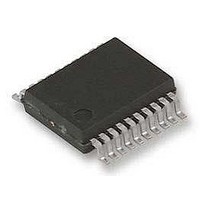ATA5743P6-TKQY 19 Atmel, ATA5743P6-TKQY 19 Datasheet - Page 6

ATA5743P6-TKQY 19
Manufacturer Part Number
ATA5743P6-TKQY 19
Description
RF Receiver UHF ASK / FSK Receiver
Manufacturer
Atmel
Type
Receiverr
Datasheet
1.ATA5743P3-TGQY.pdf
(43 pages)
Specifications of ATA5743P6-TKQY 19
Package / Case
SSO-20
Operating Frequency
449 MHz
Operating Supply Voltage
4.5 V to 5.5 V
Maximum Operating Temperature
+ 105 C
Minimum Operating Temperature
- 40 C
Mounting Style
SMD/SMT
Noise Figure
7 dB
Lead Free Status / RoHS Status
Lead free / RoHS Compliant
6
ATA5743
This is described by the following formulas:
The relation is designed to achieve the nominal IF frequency of f
F o r ap p l i c a ti o n s w h e re f
f
f
ferent conditions.
The RF input either from an antenna or from a generator must be transformed to the RF input
pin LNA_IN. The input impedance of that pin is provided in the electrical parameters. The para-
sitic board inductances and capacitances also influence the input matching. The RF receiver
ATA5743 exhibits its highest sensitivity at the best signal-to-noise ratio (SNR) in the LNA.
Hence, noise matching is the best choice for designing the transformation network.
A good practice when designing the network is to start with power matching. From that starting
point, the values of the components can be varied to some extent to achieve the best sensitivity.
If a SAW is implemented into the input network, a mirror frequency suppression of P
can be achieved. There are SAWs available that exhibit a notch at f = 2 MHz. These SAWs
work best for an intermediate frequency of f
improved by using a SAW. In typical automotive applications, a SAW is used.
Figure 4-2 on page 7
f
50 without a SAW. The input matching networks shown in
ence networks for the parameters given in the table
Table 4-1.
MODE
MODE
RF
IF
RF
Conditions
f
f
300 MHz < f
MODE = 0
365 MHz < f
MODE = 1
RF
RF
is then dependent on the logical level at pin MODE and on f
= 433.92 MHz, using a SAW.
= 433.92 MHz, MODE must be set to “1”. For other RF frequencies, f
= 315 MHz, MODE = 0
= 433.92 MHz, MODE = 1
=
=
0 (USA) : f
1 (Europe) : f
RF
RF
Calculation of LO and IF Frequency
< 365 MHz,
< 450 MHz,
IF
IF
=
shows a typical input matching network, for f
--------- -
314
=
f
LO
----------------- -
432.92
R F
f
LO
= 3 15 M H z , M O D E m us t be s e t t o “0 ” . In t he c a s e o f
Figure 4-3 on page 7
Local Oscillator Frequency
f
f
f
f
LO
LO
LO
LO
= 314 MHz
= 432.92 MHz
=
=
------------------- -
1
--------------------------- -
1
+
+
f
RF
--------- -
314
----------------- -
432.32
f
RF
1
1
IF
= 1 MHz. The selectivity of the receiver is also
“Electrical Characteristics” on page
illustrates an according input matching to
Figure 4-3 on page 7
RF
IF
.
Intermediate Frequency
f
f
= 1 MHz for most applications.
f
f
Table 4-1
IF
IF
IF
IF
= 1 MHz
= 1 MHz
=
=
--------- -
314
----------------- -
432.92
f
LO
IF
f
LO
is not equal to 1 MHz.
RF
summarizes the dif-
= 315 MHz and
4839B–RKE–08/05
are the refer-
Ref
= 40 dB
33.














